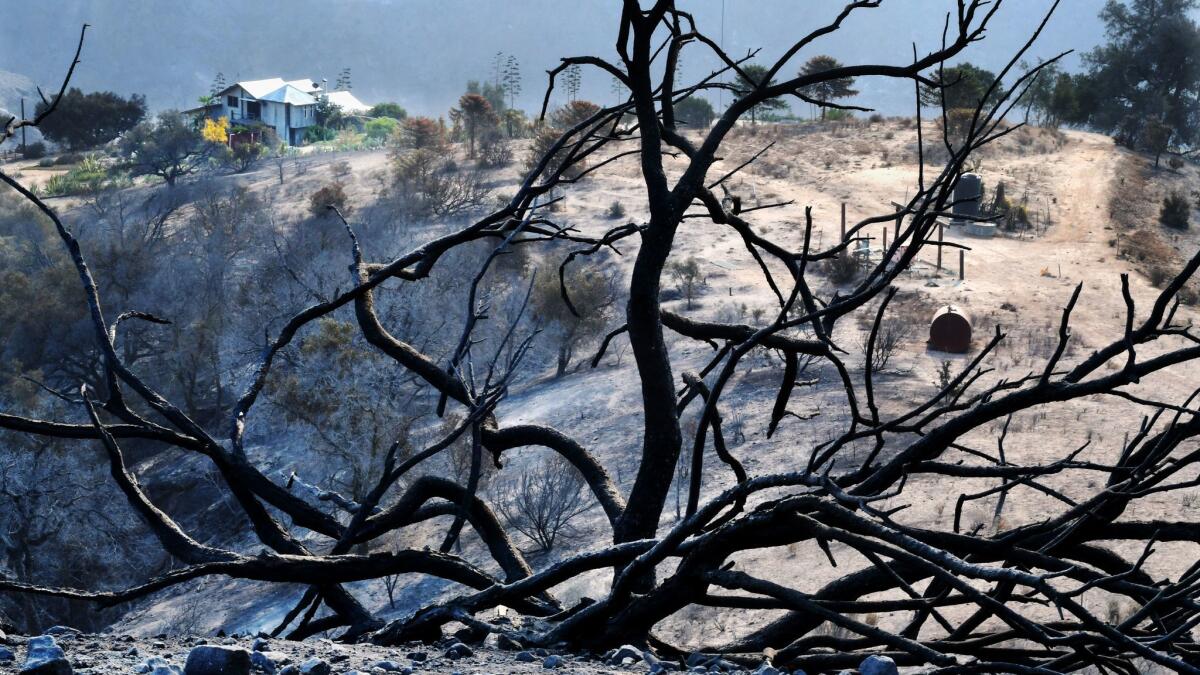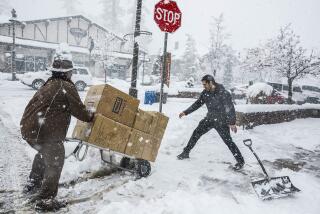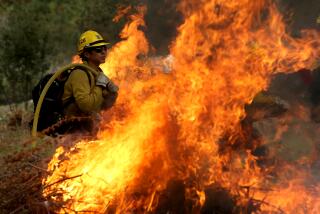Rains finally arrive, bringing new danger in California’s vast fire zones

In the mountains above coastal Santa Barbara County, the vegetation is typically so deep and lush that it can soak up a half-inch of rainwater before it flows downhill.
But that was before the Thomas fire swept through in December, burning those trees and brush to the ground. Now, the rain has no buffer, and that is cause for alarm.
“It hits the dirt directly and it is instant runoff and carries that sediment,” Thomas D. Fayram, the deputy public works director for the county, told concerned residents at a community meeting several weeks ago.
Southern California is about to get its first significant rainstorm in nearly a year this week, with more than 4 inches of rain expected in burn areas.
Particularly vulnerable
The historic lack of precipitation and unusually warm conditions, combined with a season of destructive wildfires, have left the Southland particularly vulnerable to mudslides and flooding. Besides the Thomas fire areas, officials are on watch in Sylmar, northern San Diego county, Santa Clarita and Bel-Air, where December firestorms together burned more than 1,000 homes.
RELATED: How fires bring mudslides
Some burn areas are coated in a hydrophobic, oily sheen left by the fires while other areas have been transformed into a moonscape, where the heat was so intense that nothing, not even vegetation below the surface, was left intact. The drought also weakened root systems, further destabilizing hillsides.
Now, too much water at once is the enemy. How the affected communities would manage a powerful storm depends on how much, how fast and where the rain will fall.
According to the National Weather Service, the first significant storm of the season for California is inbound. It’s expected to reach the coast by Monday and could drop 1 to 2 inches over 24 hours along the coasts and valleys and more than twice that in the mountains. The storm spans the state and will dump water on Northern California’s wine country and as far south as San Diego.
“This will be fairly widespread, certainly bigger than anything we’ve had this year,” said meteorologist John Dumas.
Debris flow this week
The rain could fall at half an inch or more an hour, which would be strong enough to trigger debris flows, he said. Areas north of Sylmar and around Sunland could see flooding and debris flows from the Creek and La Tuna fires, respectively.
RELATED: How do debris flows and mudslides differ?
In Ventura and Santa Barbara counties, a single heavy downpour could be a mixed blessing by washing away debris immediately but also clogging tributaries, said Ron Merckling, a spokesman for the Casitas Municipal Water District.
His district pumps water diverted from the Ventura River into Lake Casitas and relies on a 100-mile network of pipes with pumps, tributaries and creeks to supply water to 60,000 to 70,000 western Ventura County residents from upper Ojai to the beach. When that rain sweeps clean the hillsides, it’s going to carry sticks, brush, heavy metals and all kinds of other debris.

Turbidity “curtains” that will block sediment from flowing downriver and drop it to the surface are being placed on Santa Ana and Coyote creeks and near an intake structure for Castaic Dam, he said. Booms that skim the surface and are up to 20 feet wide will block floating material such as wood and brush. But all of that won’t be in place until the end of January, he said. In the meantime, the agency will let the first surge of storm runoff flow downriver without being diverted for public use.
Merckling guessed the area’s biggest issue this week will be mud and debris flows blocking roads.
“Have you driven though Casitas Springs? When you look at that hillside — it doesn’t look that good,” he said.
Lessons from the past
During the La Conchita mudslide of 2005, residents on the coastline had to have water delivered by the truckload after the town’s supply line was displaced with the hill above it. The same could happen there or in the Ojai Valley, which burned in the Thomas fire and during the devastating 1985 Wheeler fire.
If those hills slip and snap pipes and bury Highway 33, water district employees would have to work remotely, Merckling said. His office has been in discussions with neighboring water districts to see if they could make office space temporarily available until any cleanup is finished.
Even if the hills don’t collapse, the fire-scarred landscape is going to repel the water to a degree not seen in years, Merckling said.
It’s an unavoidable issue that has officials concerned in Santa Barbara County, where vertical rock faces and remote forest continue to challenge crews battling the Thomas fire to this day.
Danger in higher elevations
At a community meeting in late December, Fayram, the public works official, told residents evacuated from areas threatened by the Thomas fire to prepare for flooding.
He told property owners to check FEMA maps to see if they were in a flood zone.
Above Carpinteria Creek, he cautioned, “It is almost 100% burned.”
“That is a very dangerous situation that we are looking at,” he said. “It is thousands and thousands of acres, all of it burned. It’s also steeper terrain.”
The higher the elevation, the higher the rainfall totals and the greater the danger.
“It is a mix of all the bad things,” he said.
If the watershed was not burned, there would be as much as 20 feet of vegetation cover thanks to dense chaparral that could soak up rainwater. A half-inch of rain would not even hit a person sitting under that canopy of trees.
‘Instant runoff’
“Now it hits the dirt directly and it is instant runoff and carries that sediment,” he said.
Under normal conditions, it would take from 10 to 15 inches of rain before runoff would make its way down the hills toward residents.
That is the amount of rain it takes for water to get down through the canopy and saturate the soil below it before the ground rejects any more water, he said.
“Now we will get instant runoff, 100% runoff immediately,” he said. “No time to seep in, nothing to slow it down, and it carries that sediment with it.”

After a fire tore through El Capitan Canyon last year, the area was hit with 2 1/2 inches of rain in a little over an hour. The runoff eventually became a dense slurry of ash and sediment.
Concerns about mudslides are also high in wine country, where a series of fires killed more than 40 people and destroyed more than 10,000 homes in October.
The Nuns fire destroyed 1,000 homes homes in Sonoma and Napa counties. Debris flows and flooding could be widespread and hit the city of Sonoma and wash out Highway 12, officials said. Sedimentation could begin to fill Sonoma Creek and the Napa River.
Worries in wine country
The eastern portion of the burn area, generally from Hood Mountain to Redwood Canyon, is steep and vulnerable to a deep-seated landslide.
Ash and naturally occurring asbestos are also factors to consider with runoff, according to a report from the California Department of Forestry and Fire Protection.
Jay Jasperse, chief engineer for the Sonoma County Water Agency, said the agency has been preparing for rain since the fires. His agency’s customers receive their water from the Russian River after it passes through a sand and gravel filter, but water quality is still a concern. His agency has teamed up with scientists from UC Berkeley and the U.S. Geological Survey to take water quality samples from 13 different sites during a storm, he said.
To mitigate erosion and mudslide concerns, the county has added straw wattles to tributaries and K-rails to road shoulders. Where the fire was hot enough to create a water-repelling layer to the soil, a once-in-10-years storm could create the runoff of a once-in-25-years storm, he said.
“We have not been tested yet,” he said.
For breaking California news, follow @JosephSerna on Twitter.
More to Read
Start your day right
Sign up for Essential California for news, features and recommendations from the L.A. Times and beyond in your inbox six days a week.
You may occasionally receive promotional content from the Los Angeles Times.








